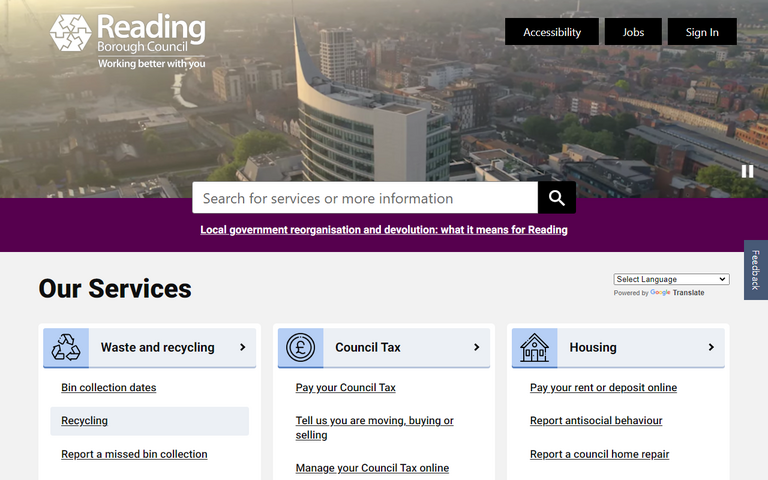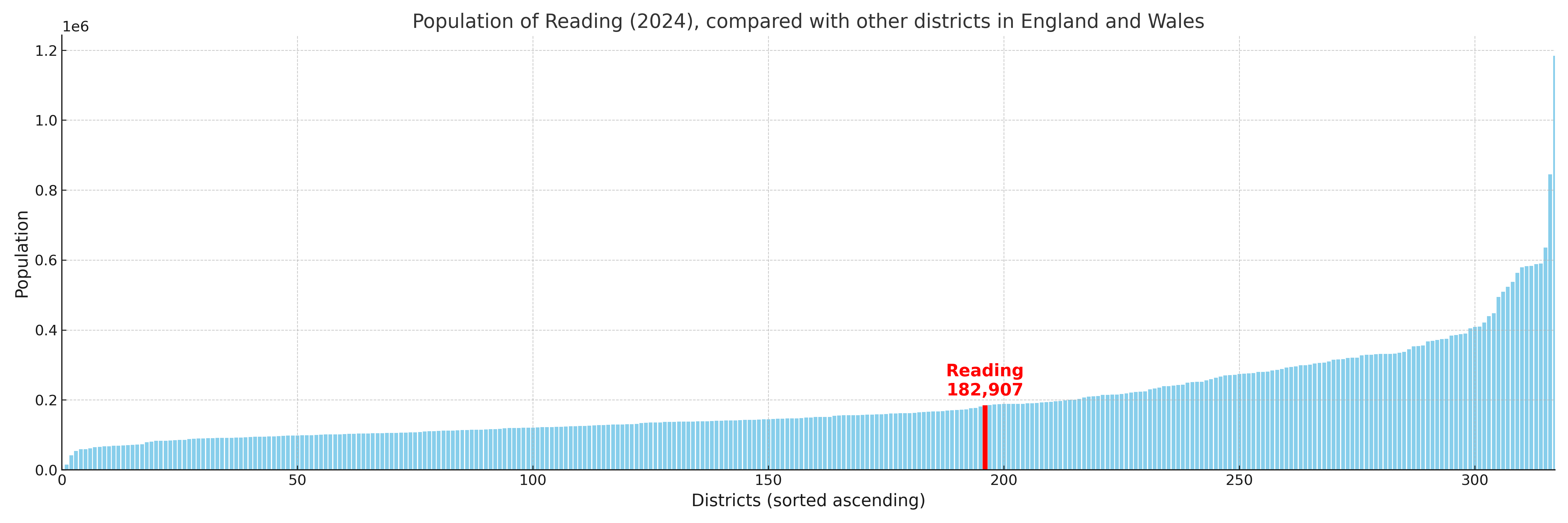Reading
§ This page gives an overview of the Reading local authority district, bringing together key facts, maps, and data to help you quickly understand the area. One of 361 district profiles on Baseview.
Overview ⁞ Reading, in Berkshire, lies on the River Thames and River Kennet, combining a busy town centre with riverside walks and parks. The town is known for Reading Abbey ruins, the Oracle shopping complex, and its major music festival. Green spaces such as Forbury Gardens and Prospect Park add leisure areas, while the rivers provide scenic routes. Surrounding suburbs and villages, along with proximity to the Thames Valley, define Reading’s landscape.
Reading Boundary Map
This map shows the official boundary of the Reading local authority district, based on the latest geographic data published by the Office for National Statistics (ONS). It provides a clear view of the district’s extent and helps you understand how the area fits within the wider regional and national landscape.
Contains OS data © Crown copyright and database right 2025. Source: Office for National Statistics licensed under the Open Government Licence v3.0.
The administrative boundary of Reading can also be viewed on OpenStreetMap: District Boundary of Reading.
Key Facts about Reading
What region is Reading in? Reading is in the South East of England, a region within the UK.
What county is Reading in? Reading is in the county of Berkshire.
Is Reading a city? No, Reading is not a city. (Note: the UK has 76 officially designated cities.)
Who governs Reading? The local government for this district is: Reading Borough Council (Unitary Authority).
▶ Official website of Reading Borough Council 🔗 reading.gov.uk

Which police force covers Reading? Policing in Reading is provided by Thames Valley Police 🔗 thamesvalley.police.uk, which serves 13 local authority districts: Bracknell Forest ⁞ Buckinghamshire ⁞ Cherwell ⁞ Milton Keynes ⁞ Oxford ⁞ Reading ⁞ Slough ⁞ South Oxfordshire ⁞ Vale of White Horse ⁞ West Berkshire ⁞ West Oxfordshire ⁞ Windsor and Maidenhead ⁞ Wokingham.
Constituencies in Reading
Reading is divided into 3 parliamentary constituencies, listed below in alphabetical order.
A constituency is a specific geographical area that elects one Member of Parliament (MP) to represent them in the House of Commons. The United Kingdom is divided into 650 parliamentary constituencies. We have this list page for easy browsing of all UK parliamentary constituencies: List of Constituencies.
Wards in Reading
Reading is divided into 16 wards, listed below in alphabetical order.
- Abbey
- Battle
- Caversham
- Caversham Heights
- Church
- Coley
- Emmer Green
- Katesgrove
- Kentwood
- Norcot
- Park
- Redlands
- Southcote
- Thames
- Tilehurst
- Whitley
In the UK, a ward is a subdivision of a local authority area, used mainly for electoral and statistical purposes. Defined by the ONS, wards represent the primary unit for local elections, each returning one or more councillors to the local council. Wards are also used as a key geography for presenting population and census data.
Parishes in Reading
Reading is entirely unparished—there are no civil parishes in this local authority district.
Parishes are the lowest tier of local government; where they don’t exist, those very local services and representation sit directly with the principal council.
Built-up Areas in Reading
Reading covers 3 built-up areas, listed below in alphabetical order.
- Caversham *
- Reading *
- Spencers Wood and Three Mile Cross *
In the UK, a Built-up Area (BUA) is a continuous urban area of at least 20 hectares (0.2 km²), defined by the ONS as land where buildings are generally no more than 200 metres apart, such as towns, cities, or large villages. (Note: A BUA name marked with an asterisk (*) indicates that the area is situated partly in the district of Reading.)
Reading compared with other districts in the UK
This section shows how Reading compares with other local authority districts in the UK, using a variety of measures and rankings.
Reading has 16 electoral wards.

Reading has a population of 182,907 (2024 mid-year estimate by ONS)

More local statistics and data for Reading can be found on the ONS statistics for Reading.